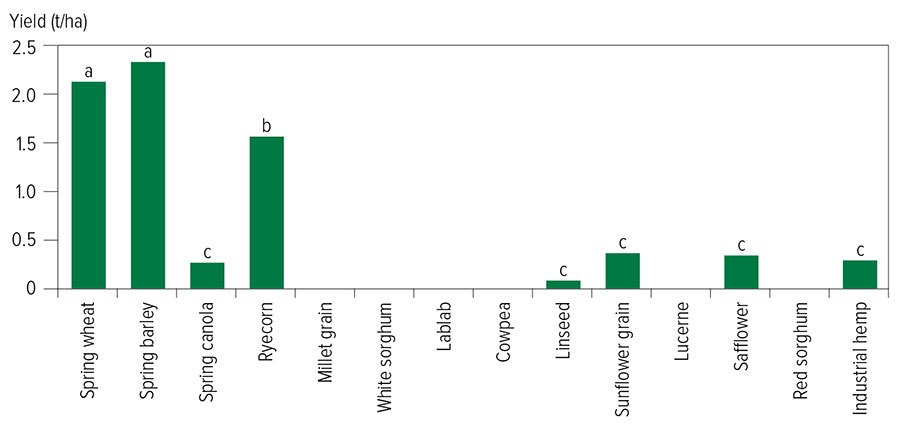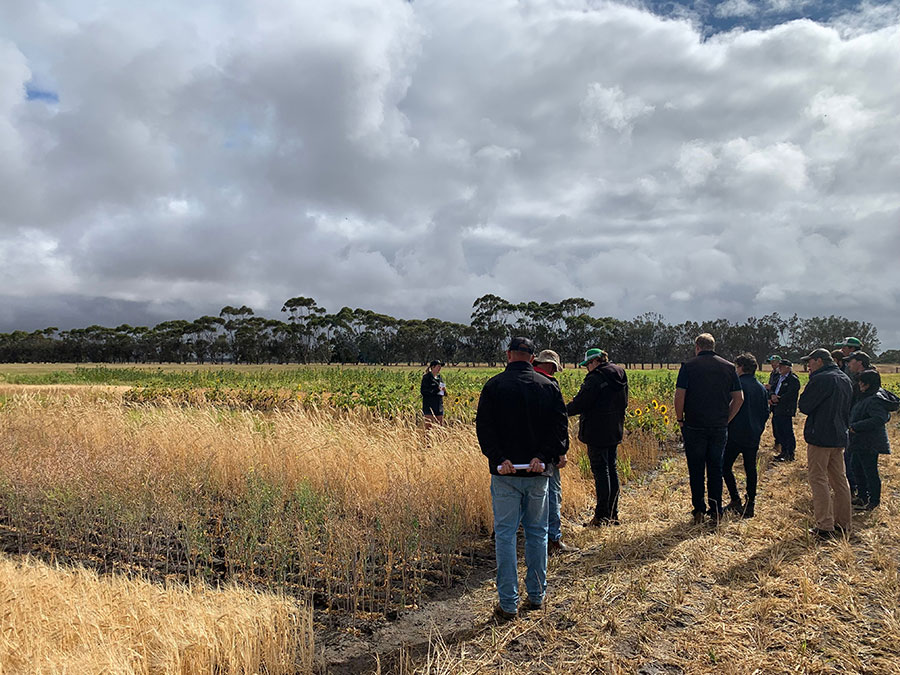By August of 2021, many parts of the Albany, Esperance and Kwinana West Port Zones of Western Australia had already exceeded decile eight rainfall levels. Waterlogging was common, occurring in the shallow duplex soils.
For many growers, crops sown in autumn had struggled or been resown and were not viable to take through to harvest. There was concern that these areas could be prone to erosion over summer, have inadequate weed control and that waterlogging could impair next years’ winter crop.
Through its agile National Grower Network, that has a mandate to assist in the development of investments that are locally relevant and have on-farm impact, GRDC sought to learn from the circumstances and invested in a summer crop trial in November 2021.
Led by Stirlings to Coast Farmers and managed by Nathan Dovey the 18-month project aimed to explore the opportunities to either sow crops in spring over these affected areas for both grain and fodder or relay crop; sow a summer crop after harvesting the winter crop.
“Broadly the agenda was about not wasting water and to go about doing this by providing growers with an opportunity to upskill their summer cropping agronomy,” Mr Dovey says.
Commonly I hear older growers say that they have tried summer cropping years ago with mixed success and increased risk but we are now in a situation where we have better adapted summer crop varieties and more sophisticated agronomic practices.
“So, in light of what the seasons are throwing at us, the time was right to take a renewed look at how this cropping practice could be used in a tactical way to improve our farming system’s sustainability.”
“Understanding the risks and logistics involved with summer cropping, such as green bridge or green island issues, soil moisture availability for the following winter crop, summer crop seed availability and marketing of the grain were all part of the considerations.”
Tactical role
Growers in the south of Western Australia deal with a mix of soil types; sandy loams over clay which can be prone to perched water tables and waterlogging and sandy soils with low water holding capacity and susceptible to salinity. These soils can be prone to erosion over summer if left with little groundcover and summer crops may play a role here.
Previous GRDC investments have found summer forage crops to be successful, not only due to the summer/autumn livestock grazing opportunity presented and successfully providing nitrogen to the following winter crop where a summer legume has been sown but also by reducing recharge which delays the onset of salinity.
“We need to cater the agronomy to summer crops, for example consider that rhizobium will be operating in warmer soils and take a closer look at the strains we are using and the rate of inoculum applied,” Mr Dovey says.
“Row spacing may also need to be reviewed as there may be opportunities to harvest summer rainfall if wider rows are used to boost summer crop productivity.”
“This could promote more vigorous summer crop growth and the development of more root mass and depth in sunflower crops to provide drainage channels for subsequent winter crops.”
“Pests and pest pressure may also be greater over the summer months and management may have to be adjusted accordingly.”
About the project
The project has established four demonstration, validation spring or summer sown field trials, it will also produce grower case studies as well as benchmark current grower practices for managing severe waterlogging and provide an economic analysis of summer crops.
“The trial work is a collaboration between us, Fitzgerald Biosphere Group, Southern Dirt and Facey Group and Nutrien Ag Solutions, hosted by several growers,” Mr Dovey says.
There are two basic trial designs for these demonstrations: a multispecies summer cropping demonstration and a single species long season winter variety demonstration.
The multispecies summer forage demonstrations contain three varieties of summer sown crops, plus a control; a chemical fallow. Where possible at least one cereal, brassica, and legume has been used to determine which species provides the best option under differing conditions for a spring sown crop, the species used are shown in Table 1.
These demonstrations have either been carried through to harvest/chemical termination or grazed/chemical termination. Given this demonstration is rotating into a winter cropping phase, spring varieties have been selected that will fit within the existing cropping rotation.
Measurements taken at each site included soil sampling for chemical analysis, soil moisture content, plant establishment counts, nodulation assessment (for legumes), biomass sampling, feed value testing (spring sown crop), tissue testing, and harvest yield and grain analysis (for those crops taken through to harvest).
For the spring crop grazing phase livestock numbers, days grazed, grazing rotations and other pertinent information have been recorded. Livestock liveweight and condition scoring data may also be collected and all agronomic inputs (fertiliser, herbicides, insecticides etc) and rainfall data for the spring crop and following winter crop will be recorded. NDVI and drone imagery has been collected where possible for the spring sown crop.
In addition to the farm scale demonstrations, a summer grains small plot trial has been conducted by Nutrien Ag solutions at Jeremy Walker’s property at Green Range. This was a replicated and randomised exploratory trial, that aims to evaluate the viability of a range crop types to be sown in the spring. These range from spring or summer sown cereals and oilseeds that are common in the area, to niche grain crops that could be viable options spring sowing in response to waterlogging or when farmers are presented with favourable conditions (Table 1).
Table1. Crop species selected for evaluation in summer crop demonstration.
Time of sowing | Crop type | Variety |
|---|---|---|
Fallow | ||
14 October | Wheat | Vixen |
14 October | Barley | Mundah |
14 October | Canola | Nuseed Emu TF |
14 October | RyeCorn | Bell Pasture Seeds |
14 October | Millet | Shirohie |
14 October | Sunflower | Aussie Stripe |
14 October | Lucerne | SG10 |
14 October | Safflower | E40-R |
11 November | Lab Lab | Highflower |
11 November | Cowpea | Ebony |
11 November | White Sorghum | Liberty |
11 November | Red Sorghum | G33 |
24 November | Industrial Hemp | Fedora |
Source: SCF
Preliminary results from small plot trials
The short season cereals sown into moisture and increasing soil temperatures established rapidly and had their first head emerging around five to six weeks after sowing. All cereals in the trial were not impacted by insect pests and as such required little to no intervention to establish. Disease pressure was low and didn’t show on the cereals until around maturity. Summer weed control was easy with a standard broadleaf brew. Cereals reached harvest maturity 11-12 weeks after sowing on average and rainfall for period 14 October to 6 April 2022 was 236 millimetres. The final yields of the species are shown in Figure 1.
Figure 1. Yields of spring or summer sown crop species grown at Jeremy Walker’s property, Green Range. Means followed by same letter do not significantly differ (P=0.05, LSD).

Source: Nutrien Ag solutions.
“The summer grass species, in comparison to spring wheat and barley struggled during the extended dry spell during the summer months with no grazing to remove foliage,” Kirsty Smith from Nutrien Ag Solutions says.
 Growers listening to Nutrien Ag Solutions Agronomist Kirsty Smith speak about summer cropping options in the Green Range district on Jeremy Walker’s property. Photo: Samantha Jeffries, SCF
Growers listening to Nutrien Ag Solutions Agronomist Kirsty Smith speak about summer cropping options in the Green Range district on Jeremy Walker’s property. Photo: Samantha Jeffries, SCF
“Insect pressure in canola was the biggest concern as the summer crops were establishing in warmer temperatures when other canola in the area was flowering. Diamond Back Moth, White Cabbage Butterfly and Vegetable Beetle all required controlling in order to get the canola established. Without multiple sprays and a bait, it is expected that we would have had no yield from the canola.”
“Using the Trueflex canola variety Emu allowed us to get good weed control at the site and canola reached maturity around 16 weeks after sowing.”
“For the niche grain species, sunflower, safflower, linseed, cowpea and lablab weed management was an issue as little was known about these crops or few chemicals were available. The legumes struggled with nodulation even with double rates of inoculant.”
“We are yet to carry out economic analysis for these summer species, but high value niche crops like the industrial hemp and safflower, either birdseed or super high oleic types may well reap good returns,” Mr Dovey says.
The sites will be sown to winter crops that will be monitored to determine rotational effects, impact on waterlogging and economic effects.
Results will be extended to growers through various Stirling to Coast Farmer publications and a project page hosted on their website.
More information: Nathan Dovey, 0429 468 030, ceo@scfarmers.org.au, Stirlings to Coast Farmers.
Read more: Summer crops' potential to lift system sustainability.

























































